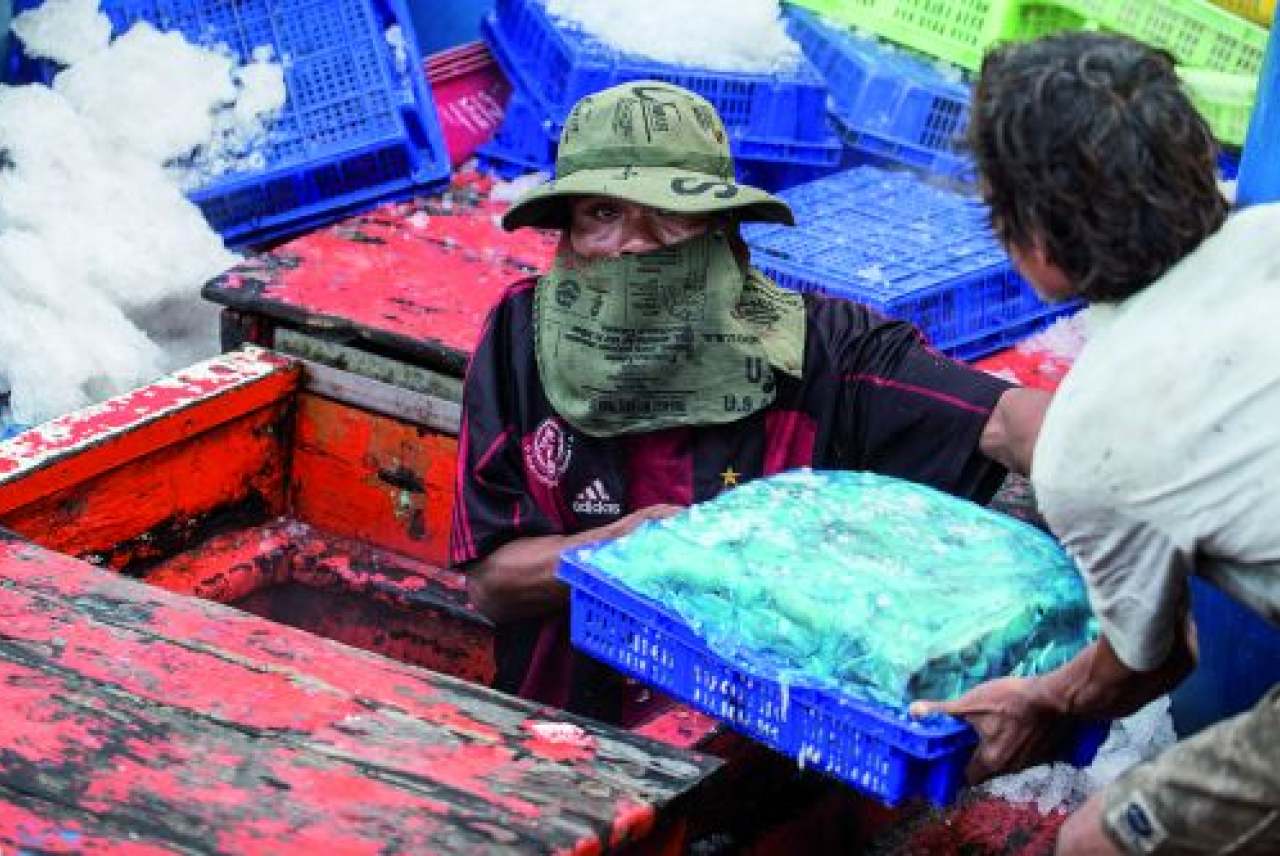In 2014 Guardian investigation found that Asian migrant workers were brutally enslaved during the production of seafood for several major UK and US supermarkets. Thailand-based Charoen Pokphand (CP) Foods, the world’s largest prawn farmer, admitted to sourcing fishmeal used to feed prawns sold on the international market from boats used by modern slavery victims.
A follow up investigation by Human Rights Watch, in January 2018, found that migrant fishermen from Southeast Asia continue to be routinely trafficked onto fishing boats; prevented from leaving or changing employers; and are often not paid for their work, or paid less than the minimum wage.
However, this is only a drop in the ocean in terms of the slavery found in consumer supply chains. According to the Global Alliance to Eradicate Forced Labour, Modern Slavery, Human Trafficking and Child Labour (also known as Alliance 8.7), an estimated 50 million people were victims of modern slavery in 2024. According to Women on Guard, in 2021 on any given day, 49.6 million people were living in modern slavery. This includes those who are forced to work against their will and those who are trapped in forced marriages.
Alliance 8.7 said, in its 2017 report, that domestic work accounted for a quarter of forced labour, followed by construction (18%), manufacturing (15%), and agriculture and fishing (11%).
What is the definition of modern slavery?
“Modern slavery” is an umbrella term that covers the offences of human trafficking and slavery, servitude, and forced or compulsory labour.
It includes the following:
- Bonded labour: when a person is forced to work to pay off a debt.
- Forced labour: when a person is coerced to work through the use of violence or intimidation.
- Descent-based slavery: when a person is born a slave because their family belongs to a class of ‘slaves’ within a society.
- Trafficking: the transport or trade of people from one area to another and into conditions of slavery.
- Child slavery: the enforced exploitation of a child for their labour for someone else’s gain.
- Early and forced marriage: when a woman is married without consent and forced into sexual and domestic servitude.
Slavery in the UK
A common misconception is that slavery only occurs in distant supply chains. However, the UK Government estimates that there are potentially between 10,000 and 13,000 victims of slavery in the UK. It states that the “complex and hidden” nature of slavery makes it impossible to accurately estimate the prevalence, but has found that the most common type of exploitation is labour exploitation followed by sexual exploitation.
The National Crime Agency recently reported that over 5,000 potential victims of modern slavery and trafficking were referred to UK authorities in 2017.
What is the UK Modern Slavery Act?
The Modern Slavery Act (MSA) 2015 is an Act of the Parliament of the United Kingdom. It consolidates previous offences relating to trafficking and slavery into a single act and focuses on the “prevention and prosecution of modern slavery and the protection of victims”. It provides this through creating greater punishments for perpetrators of modern slavery crimes and significantly increases support and rights granted to people identified as victims of slavery. It also creates, for the first time, an anti-slavery commissioner (currently Kevin Hyland) whose purpose it is to co-ordinate the UK’s response to modern slavery.
Importantly, the MSA also recognises the role that businesses play in creating conditions for slavery to exist. That is why campaigners argued for the inclusion of the Transparency in Supply Chains (TISC) clause. TISC or Section 54 of the MSA requires all companies carrying out business in the UK – regardless of where they are based – with a turnover of £36 million or more to produce an annual slavery and human trafficking statement. It requires companies to explain what they are doing to ensure slavery and trafficking are not taking place in their supply chains and businesses.
What is included in a Modern Slavery Statement?
There are two legal requirements of the statement. Firstly, it must be published on the organisation’s UK website with a link in a prominent place on the UK homepage. And secondly, it should be approved by the board of directors and signed by a director.
However, the actual content of a statement is left up to the company. In June 2017, the Corporate Responsibility Coalition (CORE) – a leading UK civil society network on corporate accountability – released a document containing “Recommended Content for a Modern Slavery Statement”.
The following areas were recommended topics:
- Structure of the organisation and its supply chains;
- Policies in relation to slavery and human trafficking;
- Due diligence processes in relation to slavery and human trafficking;
- Risk assessment and management;
- Effective action taken to address modern slavery; and
- Training on modern slavery and trafficking.
What are the problems with the MSA?
While the MSA has been welcomed by civil society organisations and transparency campaigners, there are some omissions from the TISC element which means that compliance is more a voluntary act than a compulsory one.
According to Patricia Carrier and Joe Bardwell from the Business Human Rights Resource Centre (BHRC) there is:
- no monitoring mechanism to verify whether companies that are meant to report do so;
- no enforcement mechanism for those companies that fail to report; and
- no legal consequences for simply reporting that no steps have been taken to address modern slavery.
In response to the lack of monitoring, the BHRC has set up the Modern Slavery Registe where companies can submit their statements. The registry currently has 5,538 statements, which is around half of the UK Government estimated 9,000-11,000 required. The deadline for the first round of reporting was 30 September 2017.
How well are companies reporting?
Perhaps unsurprisingly, companies are generally performing poorly when it comes to their statements and the content contained within them. The Modern Slavery Registry notes that of the statements submitted, only 19% comply with the legal standards (published on the company’s website with a link on the home page; signed by a director and approved by the board of directors).
One report, in December 2017, examined eight jewellery companies operating in the UK. Only 50% of these multi-national companies had statements available on their websites, with only 37% being fully compliant with the MSA.
Poor compliance was also found in another report by CORE, published in September 2017. The report, called ‘Risk Averse’, also found that two-thirds of the statements it studied made no reference to specific risks of slavery and human trafficking in relevant raw material supply chains or specific sectors.
Marilyn Croser, Director at CORE, told Ethical Consumer that the lack of detail in statements was “disappointing” although there were some sectors and companies that were better at mapping their supply chains than others. “It seems that many companies have adopted a lowest common dominator approach in order to comply with the regulation. In most of the statements there was very little detail. This might be because companies have decided to wait and see how others in their sector respond, or it may be that they are nervous about releasing data. We’re in the first year of the requirement so we’d hope to see companies adding more detail to their next statements.”


